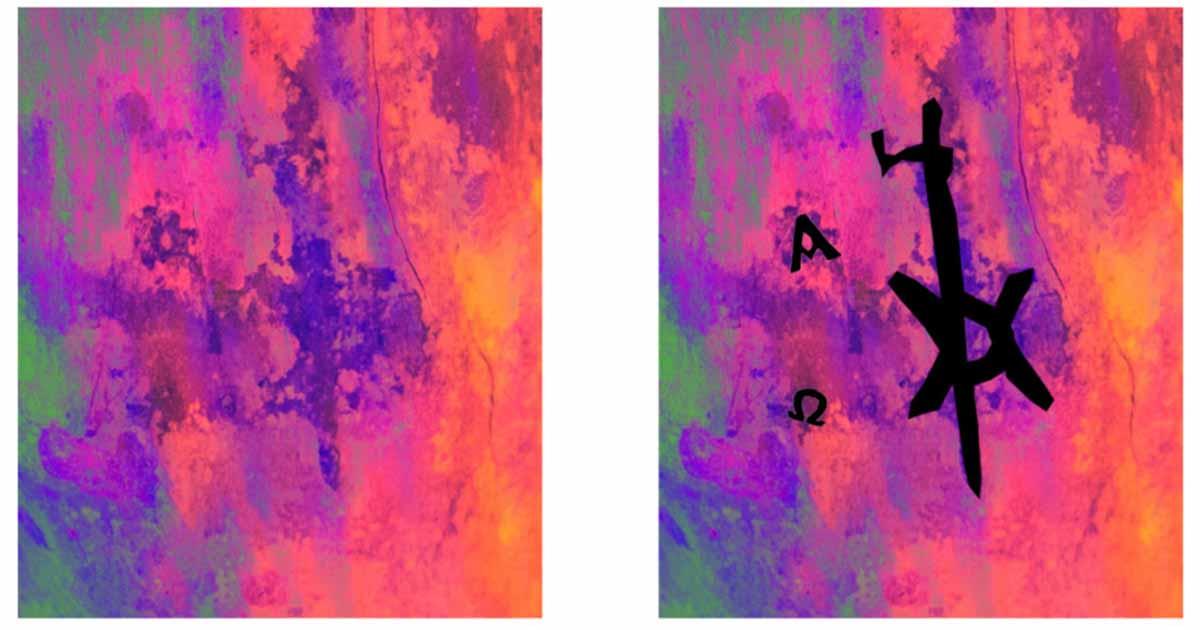
Medieval Christogram Tattoo Found in Sudan Reveals Deep Christianity
Nubia, the region that consists of modern-day Egypt and Sudan, has yielded a rather surprising find – a Christogram tattoo has been unearthed on the body of a person dating back 1,300 years. This discovery was made during excavations in a cemetery located near the medieval monastic site of Ghazali, one of the best-preserved archaeological sites in all of Sudan. This northern site is a mere 9.3 miles (15 km) from the banks of the river Nile, and the tattoo owner was likely a monk from the community.
Alpha and Omega: The Beginning and the End
This marks only the second known instance of a tattoo discovered in medieval Sudan, which was once part of the Nubian kingdom. The tattoo in question features a symbol known as a 'Christogram,' which is formed by the combination of the Greek letters 'chi' and 'rho,' serving as a monogram and abbreviation for the name of Christ. It made its debut around 324 AD when Constantine became the emperor of the Roman Empire.
It incorporates the letters alpha and omega, symbolizing the Christian belief that God is the alpha - the beginning, and the omega - the end, of all things, according to a press release by the Polish Centre of Mediterranean Archaeology, University of Warsaw (PCMA UW).

Photos and a digital image of the Christogram tattoo, Chi-Rho and Greek alpha-omega tattoo discovered at Ghazali. (Kari A. Guilbault/PCMA UW)
The researchers have unveiled images of the tattoo, captured with a full-spectrum camera, and then digitally enhanced to reveal the distinct outline of these early Christian symbols.
"It was quite a surprise to all of a sudden see what appeared to be a tattoo," said Kari A. Guilbault, a Purdue University bioarchaeologist, in the statement. "At first, I was not certain, but when the images were processed and the tattoo was clearly visible, any initial uncertainties were removed."
Guilbault, a Ph.D. candidate at Purdue University, stumbled upon this discovery by chance while photographing the remains. Despite her expertise in medieval tattooing practices, she was not originally examining the remains for potential tattoos, and she described the find as ‘totally serendipitous’ during an interview with MailOnline.
The orientation of the tattoo indicates that it was likely intended for private viewing by the individual, implying a personal significance rather than a public one. Its placement on the foot may have held symbolic meaning, possibly referencing the crucifixion of Christ or symbolizing a spiritual journey.
Christian Symbolism and Development of Ghazali Monastery
Radiocarbon dating has pinpointed the period in which the individual lived, suggesting that they were active between 667 and 774. During this era, Christianity was the dominant religion in the region, making it quite common. The person in question was likely between 35 and 50 years old at the time of their death.
While the body was discovered during excavations conducted in 2016, the tattoo's existence only recently came to light due to additional post-excavation analyses and full spectrum photography, conducted by researchers Stark and Guilbault. This discovery sheds light on the presence of early Christian symbolism in the area during that historical period, reports Live Science.

A mid-19th century painting showing the remains of the Ghazali monastery, by Karl Richard Lepsius. (Public Domain)
The Ghazali Monastery, also known as the Monastery of St. Macarius, is an ancient Coptic-Christian monastery located in Egypt's Western Desert, specifically in the Wadi El Natrun region. It stands as one of the oldest monastic communities in Egypt, known for its adherence to the Coptic Orthodox Christian tradition.
The monastery is believed to have been established during the late 7th century by King Merkurios, who was a ruler of the Nubian kingdom of Makuria. John the Deacon, an Egyptian Christian writer from around 768, referred to Merkurios as the "New Constantine," indicating his significant role in the Nubian church within the Makurian kingdom, reports The Heritage Daily.
- Ancient Nubian Super Church Changes Our Understanding of History
- Massive Cemeteries with Strange Burials Excavated at Medieval Monastery in Sudan

Ghazali Archaeological site presentation project located in the Bayuda Desert, Sudan. (PCMA)
The first excavations at Ghazali occurred in the 1950s, and subsequent excavations were carried out by PCMA UW from 2012 to 2018. These excavations unveiled several important findings, including the main monastic structure, which featured a church with a basilica layout. Additionally, cemeteries, a settlement, and evidence suggesting that Ghazali was a center for iron smelting were uncovered.
Top image: Images of the Christogram tattoo on the dorsal (top) side of the right foot. Picture was taken with a full spectrum camera and digital enhanced using ImageJ software with a DStretch plugin. Source: Kari A. Guilbault/PCMA UW
By Sahir Pandey
References
Jarus, O. 2023. 'Christ' tattoo discovered on 1,300-year-old body in Sudan. Available at: https://www.livescience.com/archaeology/christ-tattoo-discovered-on-1300-year-old-body-in-sudan.
Milligan, M. 2023. RARE CHRISTOGRAM TATTOO FOUND IN NUBIAN BURIAL. Available at: https://www.heritagedaily.com/2023/10/rare-christogram-tattoo-found-in-nubian-burial/148957.
Squire, P. 2023. Researchers investigating a medieval burial site found Christian symbols tattooed on one of the bodies' feet. Available at: https://www.businessinsider.in/science/news/researchers-investigating-a-medieval-burial-site-found-christian-symbols-tattooed-on-one-of-the-bodies-feet/articleshow/104660568.cms.
Szymanska, B. 2023. A rare medieval tattoo from Ghazali, Sudan. Available at: https://pcma.uw.edu.pl/en/2023/10/18/rare-medieval-tattoo-ghazali-sudan/
















Comments
It's quite laughable that we've historically accepted the Christ person concept as being a "white" man. He most likely wasn't, given the geographic area from which he presumably came. Most Jewish antecedants of the time had no European lineage so, therefore, to assume that a man from Jesus Christ's presumed geological and genealogical precedence was a "white" man, in our modern concept and historical pictographical depictions, is an unreasonable, unfounded conclusion. As he might have existed, Jesus of Nazareth was a brown-skinned man, not very tall and not striking in any physical sense. He might and probably was a giant, spiritually and intellectually. Maybe even "the son of God". But a fair-skinned white guy? Probably, most likely, not.